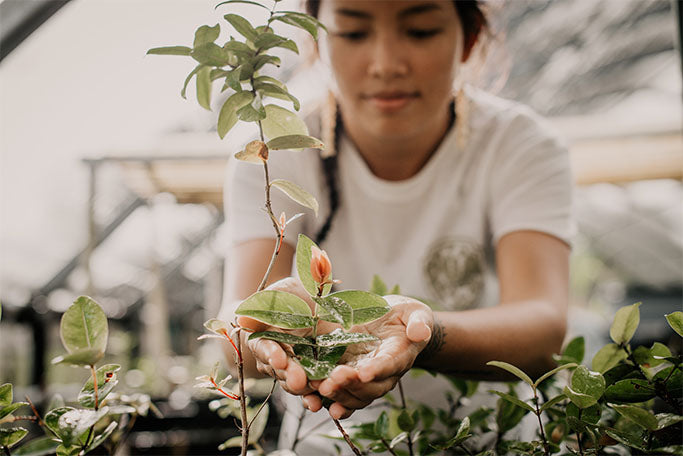RAPID ʻŌHIʻA DEATH : The growing threat on the garden isle
April 26, 2023 – Haylin Chock

I OLA ‘OE
I OLA MĀKOU NEI
“My life is dependent on yours, your life is dependent on mine.”
No other Hawaiian tree embodies this ‘olelo (saying) like ‘ōhi‘a. These trees are unique to Hawai‘i and ‘ōhi‘a forests cover nearly 1 million acres statewide.
As the backbone of the native forests of Hawai‘i, ‘ōhi‘a are a critical source of fresh water, shelter, food, and inspiration. The many relationships nurtured by these trees have inspired hula (dance), mo‘olelo (stories), mele (songs), and ‘oli (chants) for generations.
A NEWLY IDENTIFIED DISEASE
A disease called Rapid ‘Ōhi‘a Death (ROD) is infecting and killing ‘ōhi‘a on Hawai‘i Island at an alarming rate. ROD is caused by two newly discovered species of fungi: Ceratocystis lukuohia, destroyer of ‘ōhi‘a, and Ceratocystis huliohia, disrupter of ‘ōhi‘a. Both of these fungal pathogens can infect and kill ‘ōhi‘a when the fungal spores enter through an open wound in the ‘ōhi‘a tree. Over the course of a few months, the fungus spreads inside the tree until it cuts off the flow of water, killing the tree. In 2018, ROD was first detected on Kaua‘i and is now confirmed in numerous locations around the island. A rapid response team is actively monitoring and managing this sacred tree on Kaua‘i. There is no known cure or way to eradicate the disease, so we must prevent the spread of ROD wherever possible, and work together to protect ‘ōhi‘a.

SYMPTOMS OF THE DISEASE
- Leaves on limbs or entire crowns of ‘ōhi‘a trees suddenly turn yellowish or brown; dead leaves may remain on branches for some time.
- ROD-causing fungi can’t be seen from the outside; it grows and spreads within a tree for months or longer before the leaves start to wilt and brown.
- To confirm ROD in an ‘ōhi‘a tree, a wood sample must be taken and tested in a lab. If you see an ‘ōhi‘a tree with possible symptoms of ROD, please contact Kaua‘i Invasive Species Committee (KISC) and provide photos, if possible, and a specific location of the tree(s). KISC is assisting with surveying, sampling, and response.

FIVE THINGS YOU CAN DO:
- KEEP YOUR EYES OPEN: If you see ‘ōhi‘a with ROD symptoms, take a picture and contact Kaua‘i Invasive Species Committee right away. Samples of the wood must be taken by a trained technician and tested in a lab to confirm the presence of the ROD fungi.
-
AVOID INJURING ʻŌHIʻA: Avoid cutting or wounding ‘ōhi‘a and stepping on tree roots. Openings in the bark create entry points for the fungus and increase the odds that the tree could become infected with ROD.
-
CLEAN YOUR SHOES, TOOLS, AND GEAR: Fungal spores can be spread in soil from infected areas. Always clean your shoes, clothes, and gear before traveling to another island or forested area. If you work around or cut ‘ōhi‘a, clean tools and gear before and after use. Brush all dirt off equipment, then spray with 70% rubbing alcohol. Wash clothes with hot water and soap.
- WASH YOUR VEHICLE: Invasive species often move on and in vehicles. Wash the tires and undercarriage to remove all dirt, especially after traveling off-road. Take special care when shipping vehicles interisland.
- DONʻT MOVE ʻŌHIʻA: The disease can be spread to new areas by moving ‘ōhi‘a plants, plant parts, and ‘ōhi‘a wood from infected areas. Don’t transport ‘ōhi‘a interisland without a permit.


0 comments